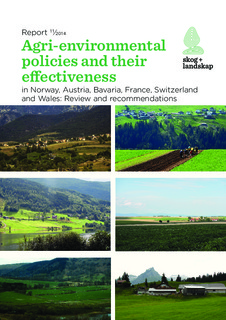| dc.contributor.author | Blumentrath, Christina | |
| dc.contributor.author | Stokstad, Grete | |
| dc.contributor.author | Dramstad, Wenche | |
| dc.contributor.author | Eiter, Sebastian | |
| dc.coverage.spatial | Norway, Austria, Bavaria, France, Switzerland, Wales | nb_NO |
| dc.date.accessioned | 2017-04-20T12:46:13Z | |
| dc.date.available | 2017-04-20T12:46:13Z | |
| dc.date.created | 2014-11-04T13:22:38Z | |
| dc.date.issued | 2014 | |
| dc.identifier.isbn | 978-82-311-0217-5 | |
| dc.identifier.issn | 1891-7933 | |
| dc.identifier.uri | http://hdl.handle.net/11250/2440142 | |
| dc.description.abstract | This review identifies ‘successful’ policies for biodiversity, cultural heritage, and landscape scenery and recreation in Austria, France, Bavaria (Germany), Wales (UK), and Switzerland, and a comparison with current efforts in Norway. All of these countries face similar risks and challenges, mostly with regard to mountain areas. Sources used for the analysis were the evaluations of the national Rural Development Plans, and the midway evaluation and national ex-post evaluations of the CAP programme period 2000–2006. An evaluation of the Swiss Direct Payment System was available from 2009, as well as information about further development from 2011. Scientific papers and other official reports by, e.g., the OECD, the European Commission and the European Environmental Agency, were used as well. Expert interviews were conducted by telephone and e-mail. Measures deemed particularly successful often had very specific aims, included local information, appeared to involve fairly simple application and organization requirements, were developed and designed in cooperation with farmers and were adapted to local characteristics or challenges. Measures considered less successful were criticized for being unfair in terms of regional repartition of grants, for lacking transparency, for being applied only to small areas, and for requiring a great deal of organization and implementation work. In terms of future developments of the Norwegian agricultural and agri-environmental subsidy system we recommend examining the following particular policies more closely: the Organic Farming scheme in Austria, the Welsh whole-farm scheme Tir Gofal, and the Austrian, Bavarian and Swiss measures for cultural landscape maintenance. Since no ‘best practice’ or ‘standard design’ of agricultural support schemes has been recognized on an international level to date, an enhanced evaluation system will be as important as new and adjusted schemes. Monitoring data suitable for comparison should be collected, based on internationally defined indicators. For the time being, we suggest “double-tracked” agri-environmental support: mainly measures that have proved to be effective; but also measures where positive effects are considered very likely due to well-known cause-effect relationships, even though they may not yet have been thoroughly documented and approved, e.g. because of their long-term character or due to weaknesses in monitoring and evaluation. | nb_NO |
| dc.language.iso | eng | nb_NO |
| dc.publisher | Norsk institutt for skog og landskap | nb_NO |
| dc.relation.ispartof | Rapport fra skog og landskap | |
| dc.relation.ispartofseries | Rapport fra skog og landskap; | |
| dc.relation.uri | http://www.skogoglandskap.no/filearchive/rapport_11-2014_agri_environmental_policies_and_their_effectiveness_in_norway_austria_bavaria_france_switzerland_and_wales.pdf | |
| dc.subject | Agricultural subsidies | nb_NO |
| dc.subject | Biodiversity | nb_NO |
| dc.subject | Cultural heritage | nb_NO |
| dc.subject | Landscape scenery | nb_NO |
| dc.subject | Recreation | nb_NO |
| dc.title | Agri-environmental policies and their effectiveness in Norway, Austria, Bavaria, France, Switzerland and Wales: Review and recommendations | nb_NO |
| dc.type | Research report | nb_NO |
| dc.subject.nsi | VDP::Landbruks- og Fiskerifag: 900::Landbruksfag: 910::Naturressursforvaltning: 914 | nb_NO |
| dc.source.pagenumber | 57 | nb_NO |
| dc.source.issue | 11 | nb_NO |
| dc.identifier.cristin | 1169797 | |
| dc.relation.project | Norges forskningsråd: 186911 | nb_NO |
| cristin.ispublished | true | |
| cristin.fulltext | original | |
